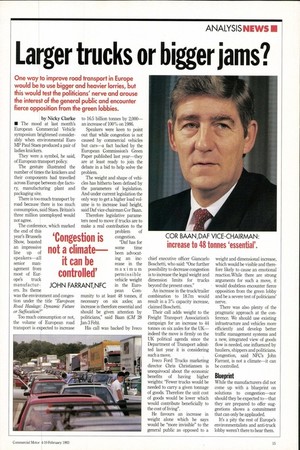Larger trucks or bigger jams?
Page 17

If you've noticed an error in this article please click here to report it so we can fix it.
One way to improve road transport in Europe would be to use bigger and heavier lorries, but this would test the politicians' nerve and arouse the interest of the general public and encounter fierce opposition from the green lobbies.
by Nicky Clarke • The mood at last month's European Commercial Vehicle symposium brightened considerably when environmental Euro MP Paul Staes produced a pair of ladies knickers.
They were a symbol, he said, of European transport policy.
The gesture illustrated the number of times the knickers and their components had travelled across Europe between dye factory, manufacturing plant and packaging site.
There is too much transport by road because there is too much consumption, said Staes. Britain's three million unemployed would not agree.
ope's truck manufacturers. Its theme was the environment and congestion under the title "European. Road Haulage: Dynamic Future or Suffocation?"
Too much consumption or not, the volume of European road transport is expected to increase to 16.5 billion tonnes by 2,000— an increase of 100% on 1986.
Speakers were keen to point out that while congestion is not caused by commercial vehicles but cars—a fact backed by the European Commission's Green Paper published last year—they are at least ready to join the debate in a bid to help solve the problem.
The weight and shape of vehicles has hitherto been defined by the parameters of legislation. And under current legislation the only way to get a higher load volume is to increase load height, said Daf vice-chairman Cor Baan.
Therefore legislative parameters need to move if trucks are to make a real contribution to the problem of congestion.
"Daf has for His call was backed by Iveco chief executive officer Giancarlo Boschetti, who said: "One further possibility to decrease congestion is to increase the legal weight and dimension limits for trucks beyond the present ones."
An increase in the truck/trailer combination to 18.7m would result in a 3% capacity increase, claimed Boschetti.
Their call adds weight to the Freight Transport Association's campaign for an increase to 44 tonnes on six axles for the UK— indeed the move is firmly on the UK political agenda since the Department of Transport admitted last year it is considering such a move.
Iveco Ford Trucks marketing director Chris Christiansen is unequivocal about the economic benefits of having higher weights: "Fewer trucks would be needed to carry a given tonnage of goods. Therefore the unit cost of goods would be lower which would contribute beneficially to the cost of living".
He favours an increase in weight alone which he says would be "more invisible" to the general public as opposed to a weight and dimensional increase, which would be visible and therefore likely to cause an emotional reaction.While there are strong arguments for such a move, it would doubtless encounter fierce opposition from the green lobby and be a severe test of politicians' nerve.
There was also plenty of the pragmatic approach at the conference. We should use existing infrastructure and vehicles more efficiently and develop better traffic management systems and a new, integrated view of goods flow is needed, one influenced by hauliers, shippers and politicians. Congestion, said NFC's John Farrant, is not a climate—it can be controlled.
Blueprint While the manufacturers did not come up with a blueprint on solutions to congestion—nor should they be expected to—that they are prepared to offer suggestions shows a commitment that can only be applauded.
It's a pity the rest of Europe's environmentalists and anti-truck lobby weren't there to hear them.
















































































